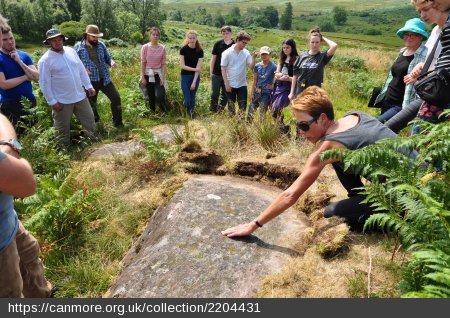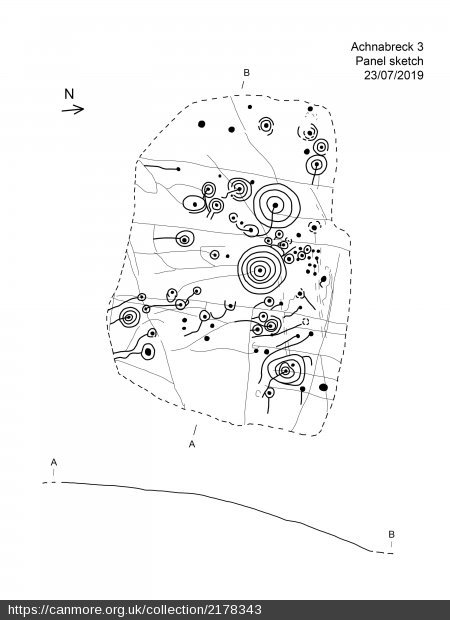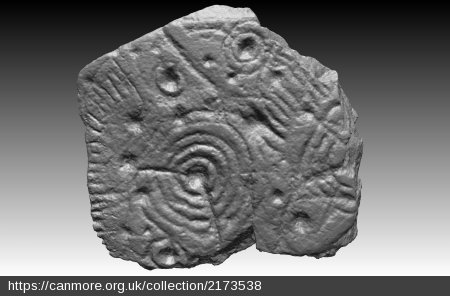Freddie Alexander is Digital Archivist at Historic Environment Scotland.
In December 2021 Scotland’s Rock Art Project (ScRAP) came to an end. ScRAP was a five-year project funded by the Arts and Humanities Research Council (AHRC) and hosted by Historic Environment Scotland (HES). It was the first major archaeological research project into prehistoric rock art in Scotland, and one of the largest and most ambitious rock art projects in the world. During the project the ScRAP team co-produced with community groups a wealth of digital data, including photographs, digitised sketches, close-range photogrammetry models, and an extensive database of fieldwork data for over 1100 prehistoric rock art panels across Scotland.

Image © HES. Team work, Scotland's Rock Art Project, Over Glenny 9, Stirling.
One of ScRAP’s goals was to deposit its data in the HES archive. HES holds the National Record for the Historic Environment, making it the obvious choice for this valuable archaeological collection. In April 2021 I was hired as a project archivist to appraise, ingest, and catalogue the ScRAP archive. With nine months to deal with over 141,000 digital files, it certainly was a daunting task!
My first objective was to familiarise myself with the scope of digital data generated by ScRAP, and then develop a workflow for appraising, ingesting, and cataloguing this data. To achieve this I collaborated closely with the ScRAP team and the HES archives department. I am not a trained archaeologist, so there was a veritable encyclopaedia of specialist terminology to wrap my head around. Thankfully I was working with some world leaders on prehistoric rock art, who were extremely patient as I disentangled my Neolithics from my Mesolithics.

Image © HES. Scanned image of rock art panel sketch, Achnabreck 3, Kilmartin, Argyll and Bute.
I was also responsible for communicating specialist information. Entrusting your research data and intellectual property to an archive is a relationship that requires careful management. Decisions that seem mundane to an archivist, such as appraisal, can be surprising and confusing to someone outside of the profession. Equally, enforcing legal boundaries with regards to intellectual property ownership and data protection can create a rocky environment. To navigate this I aimed to use to clear language at all times, avoiding technical jargon and ensuring that everyone I spoke with understood what I was saying. Terms like ‘data’ and ‘access’ have implicit meanings depending on the situation in which they are used, so I closed many conversations by asking if we understood each other.
One specific challenge was capturing appropriate metadata for archiving 3D photogrammetry models. When I joined the project in April 2021 many of these 3D models had already been created using proprietary software (Agisoft). Guidance from organisations such as the Archaeological Data Service (ADS) was essential in approaching this challenge, but our solution had to meet the time restrictions of the cataloguing project. We used Agisoft’s ‘metashape report’ function to export 3D model metadata in pdf format and archived this alongside migrated .obj and .mtl files. In addition to this we wrote a metadata mapping document that concatenated fields in the Agisoft metashape report against 3D modelling metadata guidance from ADS, HES, and the Welsh Royal Commission.

Image © HES. Snapshot of 3D model, Baldardo, Angus.
ScRAP has marked an important period of development for Historic Environment Scotland. In 2021 HES was awarded Core Trust Seal status. Additionally, AHRC has since recommended data management plans for funded archaeological projects. The ScRAP archive has knitted the HES archaeological and archive departments more closely and demonstrated that collaboration will be essential to preserve future digital projects. Just as the project archive will be an important resource for understanding Scotland’s prehistory, ScRAP has equally demonstrated that digital preservation is a group effort. As noted in the ‘Digital Archiving in Archaeology’ special issue for ‘Internet Archaeology,’:
“by developing common understandings around the stewardship of digital archaeological data, building new support and best-practice networks and more inclusive research partnerships, progress can be made to save the archaeological research legacy from the digital Dark Age.” (Richards, J.D., Jakobsson, U., Novák, D., Štular, B. and Wright, H. 2021 Digital Archiving in Archaeology: The State of the Art. Introduction, Internet Archaeology 58. https://doi.org/10.11141/ia.58.23)








































































































































